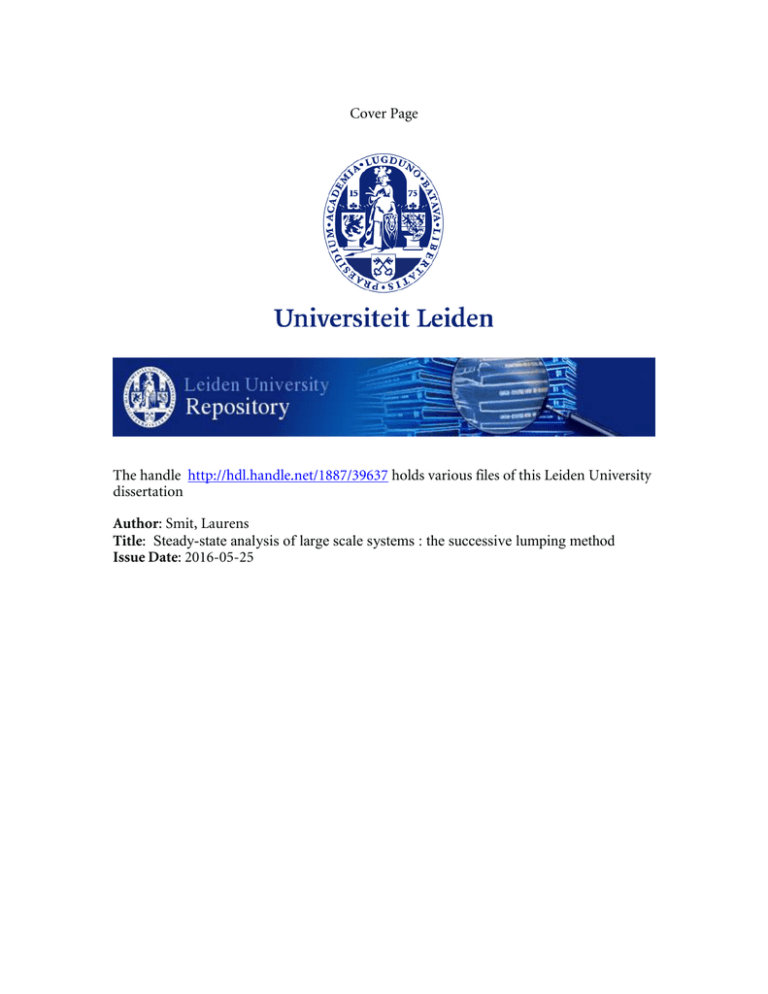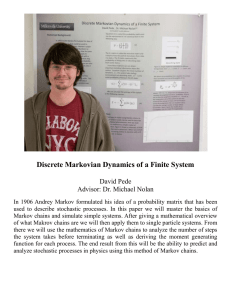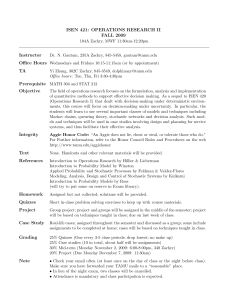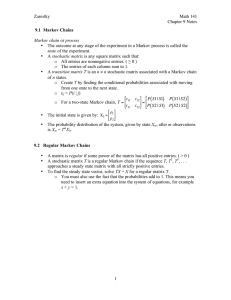Cover Page The handle http://hdl.handle.net/39637 holds
advertisement

Cover Page The handle http://hdl.handle.net/1887/39637 holds various files of this Leiden University dissertation Author: Smit, Laurens Title: Steady-state analysis of large scale systems : the successive lumping method Issue Date: 2016-05-25 Bibliography Self-references [S1] Katehakis, M. N. and Smit, L. C. “On computing optimal (Q,r) replenishment policies under quantity discounts”. Annals of Operations Research, 200(1):279–298, 2012. [S2] Katehakis, M. N. and Smit, L. C. “A successive lumping procedure for a class of Markov chains”. Probability in the Engineering and Informational Sciences, 26(4):483–508, 2012. [S3] Katehakis, M. N., Smit, L. C., and Spieksma, F. M. “DES and RES processes and their explicit solutions”. Probability in the Engineering and Informational Sciences, 29(02):191–217, 2015. [S4] Katehakis, M. N., Smit, L. C., and Spieksma, F. M. “A comparative analysis of the successive lumping and the lattice path counting algorithms”. Journal of Applied Probability, 53(1):106–120, 2016. [S5] Katehakis, M. N., Smit, L. C., and Spieksma, F. M. “On the solution to a system of equations arising in stochastic processes”. Submitted to Mathematics of Operations Research, 2016. [S6] Ertiningsih, D., Katehakis, M. N., Smit, L. C., and Spieksma, F. M. “Level product form QSF processes and an analysis of queues with Coxian interarrival distribution”. Accepted at Naval Research Logistics, 2015. [S7] Ertiningsih, D., Smit, L. C., and Spieksma, F. M. “Extensions to successive lumping”. In preparation, 2016. [S8] Katehakis, M. N., Smit, L. C., and Spieksma, F. M. “Shortest expected delay routing with arbitrary service rates”. In preparation, 2016. References [9] Adan, I. J. B. F., Kapodistria, S., and van Leeuwaarden, J. S. H. “Erlang arrivals joining the shorter queue”. Queueing Systems, 74(2-3):273–302, 2013. [10] Adan, I. J. B. F., van de Waarsenburg, W. A., and Wessels, J. “Analyzing Ek |Er |c queues”. European Journal of Operational Research, 92(1):112–124, 1996. [11] Adan, I. J. B. F., Boxma, O. J., Kapodistria, S., and Kulkarni, V. G. “The shorter queue polling model”. Annals of Operations Research, pages 1–34, 2013. 173 Bibliography [12] Adan, I. J. B. F., Economou, A., and Kapodistria, S. “Synchronized reneging in queueing systems with vacations”. Queueing Systems, 62(1-2):1–33, 2009. [13] Adan, I. J. B. F. and Wessels, J. “Shortest expected delay routing for Erlang servers”. Queueing systems, 23(1-4):77–105, 1996. [14] Adan, I. J. B. F., Wessels, J., and Zijm, W. H. M. “A compensation approach for twodimensional Markov processes”. Advances in Applied Probability, pages 783–817, 1993. [15] Akritas, A. G., Akritas, E. K., and Malaschonok, G. I. “Various proofs of Sylvester’s (determinant) identity”. Mathematics and Computers in Simulation, 42(4):585–593, 1996. [16] Alexanderian, A. “On continuous dependence of roots of polynomials on coefficients”. Retrieved from http://users.ices.utexas.edu/∼alen/articles/polyroots.pdf, 2013. [17] Ammar, G. S. “Classical foundations of algorithms for solving positive definite Toeplitz equations”. Calcolo, 33(1-2):99–113, 1996. [18] Ammar, G. S. and Gragg, W. B. “Superfast solution of real positive definite Toeplitz systems”. SIAM Journal on Matrix Analysis and Applications, 9(1):61–76, 1988. [19] Anderson, W. J. Continuous-time Markov Chains: An Applications-oriented Approach, volume 7. Springer-Verlag, New York, NY, 1991. [20] Artalejo, J. R., Economou, A., and Lopez-Herrero, M. J. “The maximum number of infected individuals in SIS epidemic models: Computational techniques and quasi-stationary distributions”. Journal of Computational and Applied Mathematics, 233(10):2563–2574, 2010. [21] Artalejo, J. R. and Gómez-Corral, A. “Retrial queueing systems”. Mathematical and Computer Modelling, 30(3-4):xiii–xv, 1999. [22] Asmussen, S. Applied Probability and Queues, volume 2. Springer-Verlag, New York, NY, 2003. [23] Asmussen, S., Nerman, O., and Olsson, M. “Fitting phase-type distributions via the EM algorithm”. Scandinavian Journal of Statistics, pages 419–441, 1996. [24] Baer, N., Boucherie, R. J., and van Ommeren, J. K. “The PH/PH/1 multi-threshold queue”. In Analytical and Stochastic Modeling Techniques and Applications, pages 95–109. Springer, 2014. [25] Barrett, W. W. and Feinsilver, P. J. “Inverses of banded matrices”. Linear Algebra and its Applications, 41:111–130, 1981. [26] Ben-Israel, A. and Greville, T. N. E. Generalized inverses: theory and applications, volume 15. Springer Science & Business Media, 2003. [27] Bhat, U. N. An Introduction to Queueing Theory: Modeling and Analysis in Applications. Springer Science & Business Media, 2008. [28] Bhulai, S. “On the value function of the M |Cox(r)|1 queue”. Journal of Applied Probability, 43(2):363–376, 2006. 174 Bibliography [29] Bini, D. A., Latouche, G., and Meini, B. Numerical methods for structured Markov chains. Oxford University Press, 2005. [30] Bini, D. A. and Meini, B. “On the solution of a nonlinear matrix equation arising in queueing problems”. SIAM Journal on Matrix Analysis and Applications, 17(4):906– 926, 1996. [31] Bini, D. A., Meini, B., Steffé, S., and Van Houdt, B. “Structured markov chains solver: software tools”. In Proceeding from the 2006 workshop on Tools for solving structured Markov chains, page 14, Pisa, Italy, 2006. ACM. [32] Böhm, W., Krinik, A., and Mohanty, S. G. “The combinatorics of birth-death processes and applications to queues”. Queueing Systems, 26(3-4):255–267, 1997. [33] Bright, L. and Taylor, P. G. “Calculating the equilibrium distribution in level dependent quasi-birth-and-death processes”. Stochastic Models, 11(3):497–525, 1995. [34] Brown, M., Peköz, E. A., and Ross, S. M. “Some results for skip-free random walk”. Probability in the Engineering and Informational Sciences, 24(04):491–507, 2010. [35] Coombs-Reyes, J. D. “Customer allocation policies in a two server network: stability and exact asymptotics”. PhD Thesis, 2003. [36] Derman, C., Lieberman, G. J., and Ross, S. M. “On the optimal assignment of servers and a repairman”. Journal of Applied Probability, pages 577–581, 1980. [37] Eisenblätter, A., Wessäly, R., Martin, A., Fügenschuh, A., Wegel, O., Koch, T., Achterberg, T., and Koster, A. “Modelling feasible network configurations for UMTS”. In Telecommunications Network Design and Management. Springer, United States, 2003. [38] Etessami, K., Wojtczak, D., and Yannakakis, M. “Quasi-birth-death processes, treelike QBDs, probabilistic 1-counter automata, and pushdown systems”. Performance Evaluation, 67(9):837–857, 2010. [39] Feinberg, B. N. and Chui, S. S. “A method to calculate steady state distributions of large Markov chains by aggregating states”. Operations Research, 35(2):282–290, 1987. [40] Flajolet, P. and Guillemin, F. “The formal theory of birth-and-death processes, lattice path combinatorics and continued fractions”. Advances in Applied Probability, 32(3):750–778, 2000. [41] Flatto, L. and McKean, H. P. “Two queues in parallel”. Communications on Pure and Applied Mathematics, 30(2):255–263, 1977. [42] Foschini, G. J. “On heavy traffic diffusion analysis and dynamic routing in packet switched networks”. Computer Performance, pages 499–513, 1977. [43] Frostig, E. “Jointly optimal allocation of a repairman and optimal control of service rate for machine repairman problem”. European Journal of Operational Research, 116(2):274–280, 1999. [44] Gaver, D. P., Jacobs, P. A., and Latouche, G. “Finite birth-and-death models in randomly changing environments”. Advances in Applied Probability, pages 715–731, 1984. 175 Bibliography [45] Gillent, F. and Latouche, G. “Semi-explicit solutions for M/PH/1-like queuing systems”. European Journal of Operational Research, 13(2):151–160, 1983. [46] Grassmann, W. K. “Real eigenvalues of certain tridiagonal matrix polynomials, with queueing applications”. Linear Algebra and its Applications, 342(1):93–106, 2002. [47] Gross, D. and Miller, D. R. “The randomization technique as a modeling tool and solution procedure for transient Markov processes”. Operations Research, 32(2):343– 361, 1984. [48] Hager, W. W. “Updating the inverse of a matrix”. SIAM review, 31(2):221–239, 1989. [49] He, Q. M. and Neuts, M. F. “Markov chains with marked transitions”. Stochastic Processes and their Applications, 74(1):37–52, 1998. [50] Heinig, G. and Rost, K. Algebraic Methods for Toeplitz-like Matrices and Operators. Springer, Basel, Switserland, 1984. [51] Hooghiemstra, G. and Koole, G. “On the convergence of the power series algorithm”. Performance Evaluation, 42(1):21–39, 2000. [52] Hordijk, A. and Spieksma, F. “Constrained admission control to a queueing system”. Advances in Applied Probability, 21(2):409–431, 1989. [53] Hordijk, A. and Spieksma, F. “On ergodicity and recurrence properties of a Markov chain with an application to an open Jackson network”. Advances in Applied Probability, 24(2):343–376, 1992. [54] Ikebe, Y. “On inverses of Hessenberg matrices”. Linear Algebra and its Applications, 24:93–97, 1979. [55] Janssen, H. K. “On the nonequilibrium phase transition in reaction-diffusion systems with an absorbing stationary state”. Zeitschrift für Physik B Condensed Matter, 42(2):151–154, 1981. [56] Kapodistria, S. “The M/M/1 queue with synchronized abandonments”. Queueing Systems, 68(1):79–109, 2011. [57] Karlin, S. A First Course in Stochastic Processes. Academic Press INC., London, 1966. [58] Katehakis, M. N. and Derman, C. “Optimal repair allocation in a series system”. Mathematics of Operations Research, 9(4):615–623, 1984. [59] Katehakis, M. N. and Veinott Jr., A. F. “The multi-armed bandit problem: decomposition and computation”. Mathematics of Operations Research, 12(2):262–268, 1987. [60] Katehakis, M. N. and Melolidakis, C. “On the optimal maintenance of systems and control of arrivals in queues”. Stochastic Analysis and Applications, 13(2):137–164, 1995. [61] Katehakis, M. N. and Derman, C. “On the maintenance of systems composed of highly reliable components”. Management Science, 35(5):551–560, 1989. [62] Katehakis, M. N. and Melolidakis, C. “Dynamic repair allocation for a K out of N system maintained by distinguishable repairmen”. Probability in the Engineering and Informational Sciences, 2:51–62, 1 1988. 176 Bibliography [63] Kemeny, J. G. and Snell, J. L. Finite Markov Chains. D. van Nostrand Company, inc., Princeton, N.J., 1960. [64] Kharoufeh, J. P. Level-Dependent Quasi-Birth-and-Death Processes. John Wiley & Sons, Inc., Hoboken, NJ, 2011. [65] Kılıç, E. and Stanica, P. “The inverse of banded matrices”. Journal of Computational and Applied Mathematics, 237(1):126–135, 2013. [66] Kim, D. S. and Smith, R. L. “An exact aggregation algorithm for a special class of Markov chains”. Technical Report, 1989. [67] Kim, D. S. and Smith, R. L. “An exact aggregation/disaggregation algorithm for mandatory set decomposable Markov chains”. In Numerical Solution of Markov Chains, pages 89–104. 1990. [68] Koole, G. and Spieksma, F. “On deviation matrices for birth–death processes”. Probability in the Engineering and Informational Sciences, 15(2):239–258, 2001. [69] Latouche, G. and Ramaswami, V. “A logarithmic reduction algorithm for quasi-birthdeath processes”. Journal of Applied Probability, pages 650–674, 1993. [70] Latouche, G. and Ramaswami, V. Introduction to Matrix Analytic Methods in Stochastic Modeling, volume 5. ASA-SIAM Series on Statistics and Applied Probability. SIAM, Philadelphia, PA., 1999. [71] Li, H. B., Huang, T. Z., Liu, X. P., and Li, H. “On the inverses of general tridiagonal matrices”. Linear Algebra and its Applications, 433(5):965–983, 2010. [72] Liu, D. and Zhao, Y. Q. “Determination of explicit solutions for a general class of Markov processes”. In Matrix-Analytic Methods in Stochastic Models, pages 343– 358. Dekker, Basel, 1996. [73] Mallik, R. K. “The inverse of a tridiagonal matrix”. Linear Algebra and its Applications, 325(1):109–139, 2001. [74] Martinsson, P. G., Rokhlin, V., and Tygert, M. “A fast algorithm for the inversion of general Toeplitz matrices”. Computers & Mathematics with Applications, 50(5):741– 752, 2005. [75] Meurant, G. “A review on the inverse of symmetric tridiagonal and block tridiagonal matrices”. SIAM Journal on Matrix Analysis and Applications, 13(3):707–728, 1992. [76] Meyer, C. D. Matrix Analysis and Applied Linear Algebra. SIAM, 2000. [77] Miranker, W. L. and Pan, V. Y. “Methods of aggregation”. Linear Algebra and its Applications, 29:231–257, 1980. [78] Mohanty, S. G. Lattice Path Counting and Applications. Academic Press, New York, NY, 1979. [79] Mohanty, S. G. and Panny, W. “A discrete-time analogue of the M/M/1 queue and the transient solution: A geometric approach”. Sankhyā: The Indian Journal of Statistics, Series A, pages 364–370, 1990. 177 Bibliography [80] Neuts, M. F. Matrix-Geometric Solutions in Stochastic Models: an Algorithmic Approach. Courier Dover Publications, 1981. [81] Neuts, M. F. “The burstiness of point processes”. Stochastic Models, 9(3):445–466, 1993. [82] Pérez, J. and Van Houdt, B. “Quasi-birth-and-death processes with restricted transitions and its applications”. Performance Evaluation, 68(2):126–141, 2011. [83] Perros, H. G. Queueing Networks with Blocking. Oxford University Press, New York, NY., 1994. [84] Ramaswami, V. “A stable recursion for the steady state vector in Markov chains of M/G/1 type”. Stochastic Models, 4:183–188, 1988. [85] Ramaswami, V. and Latouche, G. “A general class of Markov processes with explicit matrix-geometric solutions”. Operations-Research-Spektrum, 8(4):209–218, 1986. [86] Ramaswami, V. and Lucantoni, D. M. “Algorithms for the multi-server queue with phase type service”. Stochastic Models, 1(3):393–417, 1985. [87] Righter, R. “Optimal policies for scheduling repairs and allocating heterogeneous servers”. Journal of Applied Probability, 33(2):536–547, 1996. [88] Riska, A. and Smirni, E. “M/G/1-type Markov processes: A tutorial”. In Performance Evaluation of Complex Systems: Techniques and Tools, volume 2459, pages 36–63. Springer, 2002. [89] Ross, S. M. Applied Probability Models with Optimization Applications. Holden-Day, Inc., SF, USA, 1970. [90] Ross, S. M. Stochastic Processes. John Wiley and Sons, NY., 1996. [91] Ross, S. M. Introduction to Stochastic Dynamic Programming. Academic press, Inc., NY,USA, 1983. [92] Schweitzer, P. J., Puterman, M. L., and Kindle, W. L. “Iterative aggregation-disaggregation procedures for discounted semi-Markov reward processes”. Operations Research, 33(3):589–605, 1985. [93] Selen, J., Adan, I. J. B. F., Kapodistria, S., and van Leeuwaarden, J. S. H. “Steady-state analysis of shortest expected delay routing”. arXiv:1509.03535v2, 2015. [94] Seneta, E. “Computing the stationary distribution for infinite Markov chains”. Linear Algebra and its Applications, 34:259–267, 1980. [95] Seneta, E. Non-negative Matrices and Markov Chains. Springer-Verlag, New York, NY, 2nd edition, 1980. [96] Sonin, I. M. “Optimal stopping of Markov chains and three abstract optimization problems”. An International Journal of Probability and Stochastic Processes, 83(46):405–414, 2011. [97] Spieksma, F. M. and Tweedie, R. L. “Strengthening ergodicity to geometric ergodicity for Markov chains”. Stochastic Models, 10(1):45–74, 1994. 178 Bibliography [98] Spitzer, F. Principles of Random Walk, volume 34. Springer-Verlag, New York, NY, 2001. [99] Sylvester, J. J. “XXXVII. on the relation between the minor determinants of linearly equivalent quadratic functions”. The London, Edinburgh, and Dublin Philosophical Magazine and Journal of Science, 1(4):295–305, 1851. [100] Szpankowski, W. “Stability conditions for multidimensional queueing systems with computer applications”. Operations Research, 36(6):944–957, 1988. [101] Tong, H., Faloutsos, C., and Pan, J. Y. “Fast random walk with restart and its applications”. In ICDM ’06, pages 613–622. IEEE, 2006. [102] Tweedie, R. L. “The calculation of limit probabilities for denumerable Markov processes from infinitesimal properties”. Journal of Applied Probability, pages 84–99, 1973. [103] Tweedie, R. L. “Criteria for ergodicity, exponential ergodicity and strong ergodicity of Markov processes”. Journal of Applied Probability, 18(1):122–130, 1981. [104] Ulukus, M. Y., Güllü, R., and Örmeci, L. “Admission and termination control of a two class loss system”. Stochastic Models, 27(1):2–25, 2011. [105] Ungureanu, V., Melamed, B., Katehakis, M. N., and Bradford, P. G. “Deferred assignment scheduling in cluster-based servers”. Cluster Computing, 9(2):57–65, 2006. [106] Van Houdt, B. and van Leeuwaarden, J. S. H. “Triangular M/G/1-type and tree-like quasi-birth-death Markov chains”. INFORMS Journal on Computing, 23(1):165–171, 2011. [107] van Leeuwaarden, J. S. H., Squillante, M. S., and Winands, E. M. M. “Quasi-birthand-death processes, lattice path counting, and hypergeometric functions”. Journal of Applied Probability, 46(2):507–520, 2009. [108] van Leeuwaarden, J. S. H. and Winands, E. M. M. “Quasi-birth-and-death processes with an explicit rate matrix”. Stochastic Models, 22(1):77–98, 2006. [109] Varga, R. S. Matrix Iterative Analysis. Prentice-Hall, Englewood Cliffs, NJ, 1963. [110] Varga, R. S. “On recurring theorems on diagonal dominance”. Linear Algebra and its Applications, 13(1):1–9, 1976. [111] Veinott Jr., A. F. “The optimal inventory policy for batch ordering”. Operations Research, 13(3):424–432, 1965. [112] Vere-Jones, D. “Ergodic properties of nonnegative matrices I”. Pacific Journal of Mathematics, 22(2):361–386, 1967. [113] Vlasiou, M., Zhang, J., and Zwart, B. “Insensitivity of proportional fairness in critically loaded bandwidth sharing networks”. arXiv preprint arXiv:1411.4841, 2014. [114] Williams, V. V. “Multiplying matrices faster than Coppersmith-Winograd”. In Proceedings of the 44th symposium on Theory of Computing, pages 887–898, New York, NY, 2012. ACM. 179 Bibliography [115] Woodbury, M. “Inverting modified matrices”. Memorandum Report, Statistical Research Group, 42, 1950. [116] Yap, V. B. “Similar states in continuous-time Markov chains”. Journal of Applied Probability, 46(2):497–506, 2009. [117] Zhang, Q., Mi, N., Riska, A., and Smirni, E. “Performance-guided load (un)balancing under autocorrelated flows”. IEEE Transactions on Parallel and Distributed Systems, 19(5):652–665, 2008. [118] Zhao, Y. Q. and Grassmann, W. K. “Queueing analysis of a jockeying model”. Operations Research, 43(3):520–529, 1995. [119] Zheng, Y. S. and Zipkin, P. “A queueing model to analyze the value of centralized inventory information”. Operations Research, 38(2):296–307, 1990. 180




